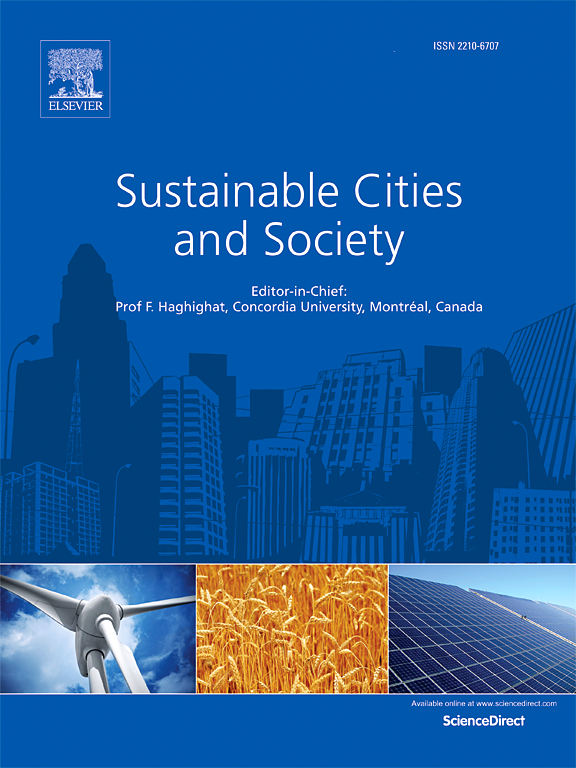城市用水量的空间格局:局地气候带和温度动态的作用
IF 10.5
1区 工程技术
Q1 CONSTRUCTION & BUILDING TECHNOLOGY
引用次数: 0
摘要
城市水资源消耗(UWC)是干旱地区面临的主要挑战,城市化、人口增长和资源短缺加剧了这一挑战,引发了关于重新安置伊朗首都以解决资源短缺和可持续性问题的争论。本研究分析了德黑兰当地气候带(LCZ)、地表温度(LST)和用水量之间的关系(2015-2019),为城市水管理提供信息。UWC的数据在空间上与城市地区相匹配,以计算人均消费量。使用随机森林(RF)算法生成2017年基准年的LCZ地图,准确率达到88.88%。5年的地表温度数据采用单通道算法推导。密集中层建筑的LCZ2面积最大,水的LCZG面积最小。年人均UWC呈持续上升趋势,其中2019年增幅最大。LCZG和LCZ2的UWC最高,而低密度单体建筑的LCZ7最低。在整个研究期间,该城市大部分地区的平均地表温度在30°C至35°C之间。人口密度、LST和UWC之间的相关性为10% ~ 17%。以均方根误差(RMSE)衡量的建模精度在1.4到9.9之间。这项研究强调了气候敏感型城市设计和可持续水管理的必要性,为解决脆弱城市地区缺水问题的政策提供了基础。此外,分析年度人口动态和改进UWC模型将有助于更好地反映未来城市用水模式。本文章由计算机程序翻译,如有差异,请以英文原文为准。
Spatial patterns in urban water consumption: The role of local climate zones and temperature dynamics
Urban Water Consumption (UWC) is a major challenge in arid regions, intensified by urbanization, population growth, and resource scarcity, prompting debates on relocating Iran's capital to address resource scarcity and sustainability. This study analyzed the relationship between Local Climate Zones (LCZ), Land Surface Temperature (LST), and water usage in Tehran (2015–2019) to inform urban water management. UWC data was spatially matched to urban areas to calculate per capita consumption. An LCZ map for the base year 2017 was generated using the Random Forest (RF) algorithm, achieving an accuracy of 88.88 %. LST data for the five years was derived using the single-channel algorithm. LCZ2 of dense midrise buildings exhibited the largest area, while LCZG of water had the smallest area. Annual per capita UWC showed a consistent upward trend, with 2019 experiencing the most significant increase. The highest UWC was in LCZG and LCZ2, respectively, while LCZ7 of low dense single buildings recorded the lowest. Most of the city's area had neighbourhoods with an average LST ranging between 30 °C and 35 °C throughout the study period. The correlation between population density, LST, and UWC was 10 % to 17 %. Modelling accuracy, measured by Root Mean Square Error (RMSE), ranged from 1.4 to 9.9. This research highlights the need for climate-sensitive urban design and sustainable water management, providing a foundation for policies to address water scarcity in vulnerable urban areas. Additionally, analyzing annual population dynamics and improving UWC modeling will help better reflect future urban water consumption patterns.
求助全文
通过发布文献求助,成功后即可免费获取论文全文。
去求助
来源期刊

Sustainable Cities and Society
Social Sciences-Geography, Planning and Development
CiteScore
22.00
自引率
13.70%
发文量
810
审稿时长
27 days
期刊介绍:
Sustainable Cities and Society (SCS) is an international journal that focuses on fundamental and applied research to promote environmentally sustainable and socially resilient cities. The journal welcomes cross-cutting, multi-disciplinary research in various areas, including:
1. Smart cities and resilient environments;
2. Alternative/clean energy sources, energy distribution, distributed energy generation, and energy demand reduction/management;
3. Monitoring and improving air quality in built environment and cities (e.g., healthy built environment and air quality management);
4. Energy efficient, low/zero carbon, and green buildings/communities;
5. Climate change mitigation and adaptation in urban environments;
6. Green infrastructure and BMPs;
7. Environmental Footprint accounting and management;
8. Urban agriculture and forestry;
9. ICT, smart grid and intelligent infrastructure;
10. Urban design/planning, regulations, legislation, certification, economics, and policy;
11. Social aspects, impacts and resiliency of cities;
12. Behavior monitoring, analysis and change within urban communities;
13. Health monitoring and improvement;
14. Nexus issues related to sustainable cities and societies;
15. Smart city governance;
16. Decision Support Systems for trade-off and uncertainty analysis for improved management of cities and society;
17. Big data, machine learning, and artificial intelligence applications and case studies;
18. Critical infrastructure protection, including security, privacy, forensics, and reliability issues of cyber-physical systems.
19. Water footprint reduction and urban water distribution, harvesting, treatment, reuse and management;
20. Waste reduction and recycling;
21. Wastewater collection, treatment and recycling;
22. Smart, clean and healthy transportation systems and infrastructure;
 求助内容:
求助内容: 应助结果提醒方式:
应助结果提醒方式:


